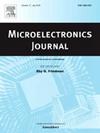基于iii型SPLL的二阶DPD线性啁啾发生器
IF 1.9
3区 工程技术
Q3 ENGINEERING, ELECTRICAL & ELECTRONIC
引用次数: 0
摘要
本文提出了一种基于锁相环的频率合成器,专门用于线性啁啾信号的产生。通过在两点调制(TPM)方案中集成二阶数字预失真(DPD)算法,该设计可同时实现宽啁啾带宽和高啁啾率。iii型锁相环架构利用其固有的精确跟踪线性频率斜坡的能力。当与DPD方案结合使用时,该方法大大减少了非线性失真校正所需的最小均方(LMS)校准支路的数量,从而在保持高阶线性化性能的同时降低了硬件复杂度。啁啾发生器采用65纳米CMOS工艺制造,产生的锯齿波带宽为1.7 GHz,啁啾速率为332 MHz/μs。仿真结果表明,RMS频率误差为186.25 kHz,仅占全啁啾带宽的0.0109%。本文章由计算机程序翻译,如有差异,请以英文原文为准。
A linear chirp generator with 2nd DPD technique based on a Type-III SPLL
This paper presents a PLL-based frequency synthesizer tailored for linear chirp signal generation. By integrating a second-order digital predistortion (DPD) algorithm within a two-point modulation (TPM) scheme, the proposed design achieves both wide chirp bandwidth and high chirp rate concurrently. A Type-III PLL architecture is employed to leverage its intrinsic capability of accurately tracking linear frequency ramps. When combined with the DPD scheme, this approach substantially reduces the number of least-mean-square (LMS) calibration branches required for nonlinear distortion correction, thereby lowering hardware complexity while preserving high-order linearization performance. Fabricated in a 65-nm CMOS process, the chirp generator produces a sawtooth waveform with a 1.7 GHz bandwidth and a chirp rate of 332 MHz/μs. Simulation results demonstrate an RMS frequency error of 186.25 kHz, corresponding to only 0.0109 % of the full chirp bandwidth.
求助全文
通过发布文献求助,成功后即可免费获取论文全文。
去求助
来源期刊

Microelectronics Journal
工程技术-工程:电子与电气
CiteScore
4.00
自引率
27.30%
发文量
222
审稿时长
43 days
期刊介绍:
Published since 1969, the Microelectronics Journal is an international forum for the dissemination of research and applications of microelectronic systems, circuits, and emerging technologies. Papers published in the Microelectronics Journal have undergone peer review to ensure originality, relevance, and timeliness. The journal thus provides a worldwide, regular, and comprehensive update on microelectronic circuits and systems.
The Microelectronics Journal invites papers describing significant research and applications in all of the areas listed below. Comprehensive review/survey papers covering recent developments will also be considered. The Microelectronics Journal covers circuits and systems. This topic includes but is not limited to: Analog, digital, mixed, and RF circuits and related design methodologies; Logic, architectural, and system level synthesis; Testing, design for testability, built-in self-test; Area, power, and thermal analysis and design; Mixed-domain simulation and design; Embedded systems; Non-von Neumann computing and related technologies and circuits; Design and test of high complexity systems integration; SoC, NoC, SIP, and NIP design and test; 3-D integration design and analysis; Emerging device technologies and circuits, such as FinFETs, SETs, spintronics, SFQ, MTJ, etc.
Application aspects such as signal and image processing including circuits for cryptography, sensors, and actuators including sensor networks, reliability and quality issues, and economic models are also welcome.
 求助内容:
求助内容: 应助结果提醒方式:
应助结果提醒方式:


